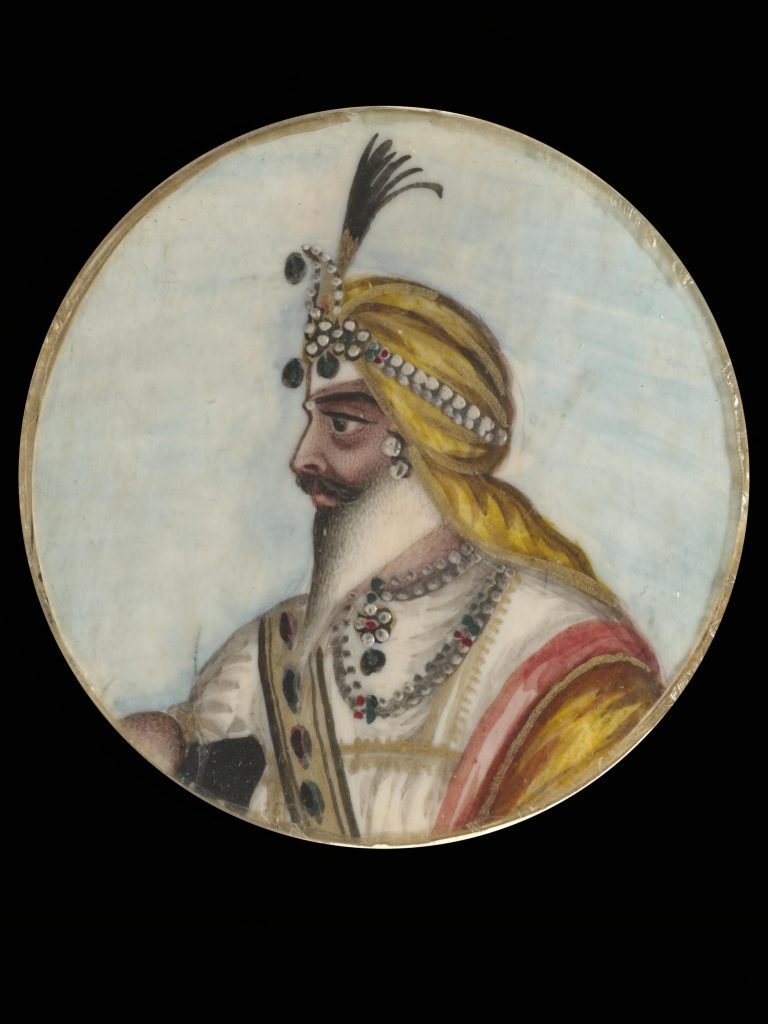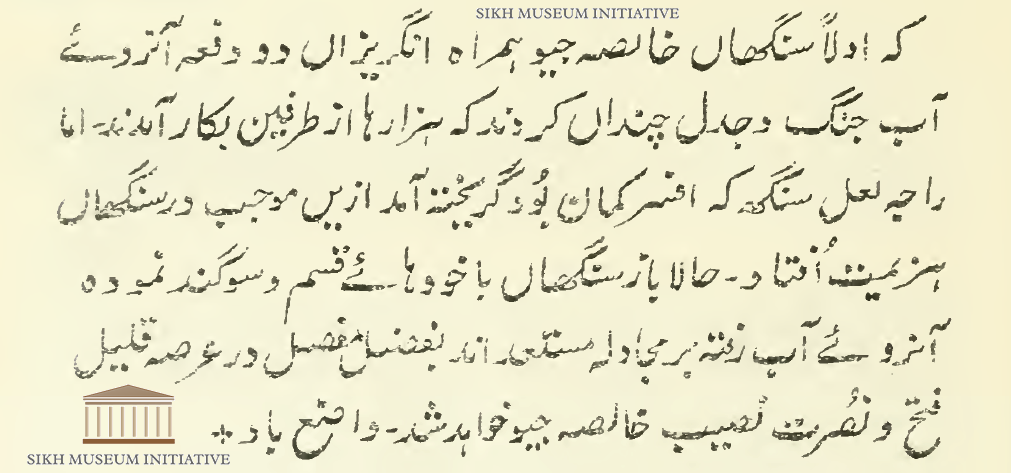
Chattar Singh Atarriwala: Painting, portrait miniature, paint on ivory, Lahore, ca. 1850-1870. © Victoria and Albert Museum, London
Letters of Chattar Singh Attariwala-Written by Damandeep Singh Sandhanwalia
S. Chattar Singh Attariwala was a commander and served as provincial governor under minor Maharaja Duleep Singh. He is better known for the lead role he played during Second Anglo Sikh War.The letters of Sardar Chattar Singh Attariwala have largely remained unnoticed. Being some one hundred and seventy-four in number, one hundred and four pertain to the 2nd Anglo-Sikh War and the remaining seventy letters relate to the First Anglo-Sikh War. [1] Though the Sardar was not part of the first War, still his letters suggest that he was receiving the inputs from his sources pertaining to the first Anglo-Sikh War.
The letters have been written by S. Chattar Singh Attariwala and are mostly addressed to Ch. Shahbaz Khan, the Kardar (Revenue Collector) of the Sardar. [1] Obtained from a descendant of Shahbaz Khan, these were supposedly in possession of the History Research Department established by H.L.O. Garrett, a formal Principal of Government College Lahore, and the Keeper of Records of the Punjab Government. These letters are in Persian as it was the official language used during the rule of Sarkar Khalsa.
Raja Lal Singh
The loss of the Sikhs in the First Anglo-Sikh War largely is because of the treachery committed by Raja Lal Singh, Raja Tej Singh and Raja Gulab Singh Dogra. Raja Lal Singh was the son of Misr Jassa Mall, a Brahmin shopkeeper of Sanghoi, in Jehlum district in West Punjab. He entered the service of the Sikh Durbar in 1832 as a writer in the treasury. He enjoyed the patronage of the Prime Minister Raja Dhian Singh Dogra. Lal Singh rose to power during Hira Singh Dogra’s authority when he was given a minor military command. [2] Later after the death of Sardar Jawahir Singh, he was appointed the Wazir (Prime Minister) of the Kingdom of Lahore. During the First Anglo Sikh War he was a Commander of the Irregular troops of the Army, the Regular troops being placed under the command of Raja Tej Singh who was the Commander-in-Chief.[3]
Anglo-Sikh War-1 Overview:
The First Anglo-Sikh War and the treachery committed by Raja Lal Singh is extensively covered in the history. A brief overview as to the conduct of Raja Lal Singh during the various battles is provided:Cunningham states: “In connection with his original design, he (Raja Lal Singh) involved his followers in an engagement and then left them to fight as their undirected valour might prompt.” [6]On 12th December 1845 when the Sikh Army was crossing Sutluj, Raja Lal Singh sent Shamshuddin Khan (or Shams-ud-Din Khan) to Captain Peter Nicholson and supplied him the military information. [3] On the instructions of Caption Nicholson to Raja Lal Singh, Firozpur which was held by Sir John Littler with only 7000 men was not attacked despite the fact that the five divisions of the Sikh Army each about 8,000-12,000 strong was available. Then Lal Singh dispersed the army in a wide semi-circle from Harike to Mudki and thence to Ferozeshah, 16 km southeast of Firozpur. [4] Battle of Mudki was fought on 18th December 1845. Though the Sikh Army strength was double than the British force, still half of them were kept out of the battlefield, the battle which eventually was won by the British. Brigadier Littler’s garrison troops were also allowed to escape from Firozpur and form junction with Lord Gough’s army later at Ferozeshah. [4] On 19th December 1845 after the Battle of Mudki, Raja Lal Singh had again sent a messenger to Major Broadfoot again offering his services. [3]
The next Battle of Ferozeshah was a decisive battle and is regarded as one of the most fiercely contested battles fought by the British in India. During that “night of horrors,” the British commander-in-chief acknowledged, “we were in a critical and perilous state.”[4] Lal Singh and Tej Singh again came to the rescue of the English. The former suddenly deserted the Khalsa army during the night and the latter the next morning (22 December) which enabled the British to turn defeat into victory. [4] Tej Singh’s guns had opened fire, but the British artillery had no shot with which to reply. Then, without any reason, Tej Singh’s guns also fell silent, and, a few minutes later, Tej Singh ordered his troops to retreat.[8]
The battle victory which truly belonged to the Sikh Army and which would have changed the history of the subcontinent, was again lost by the Sikhs owing to treachery. As per popular reports, Lal Singh had retired to Amritsar where “he concealed himself in an oven from the fury of the soldiers who swore to murder him”. [3]
Later he was seen commanding troops at Battle of Sabroan when again “on the 8th February he sent Shamshuddin Khan to Major H. Lawrence with a plan of entrenchments and the detailed account of the number and disposition of the Sikh troops”.[3] Another source suggests that through intermediaries, H. Lawrence was able to glean sufficient information from Lal Singh to enable him to prepare ‘a rough sketch of the position and strength of the enemy at Sabraon on the night of 7th February’ for transmission to the British Commander-in-Chief.” [7]
S. Chattar Singh’s letter explains Raja Lal Singh’s conduct:
An excerpt available from one of the letter written by Sardar Chatter Singh Attariwala reiterates the treacherous conduct of Raja Lal Singh during the First Anglo Sikh War. He writes:
“The Sikhs twice gave battle to the English and the
heat of the fight may be imagined from the fact that thousands
of men have been killed from either side in the action. But Raja Lal Singh, the Commanding Officer, fled away from the field. This caused a great panic among the fighting Khalsa. But still some of them have taken oaths to persevere and are fighting. By the Grace of God, Victory shall soon be ours.” [1]
Though the date of the letter is not available, the context is of the First Anglo Sikh War. Since S. Chattar Singh was not fighting in the War, his account is based on the information he received. After the Battle of Mudki, Battle of Ferozeshah was fought which as the records suggest, Sikhs would have won. This letter thus points to the fact that Raja Lal Singh had ran away from the Ferozeshah battlefield, which is also collaborated by other history sources.
Lahore Durbar’s knowledge of Lal Singh’s conduct:
This letter also brings to light another important issue. S. Chattar Singh Attariwala was thus well informed about the proceedings of the war and the treacherous conduct of Raja Lal Singh. Similarly it’s very likely that the Lahore Durbar was also informed about these acts. The Sikh soldiery was also eyeing for his blood following his conduct. However, Raja Lal Singh apparantly had some excuses to put forward in defence of his act. His “Wazarat” was taken away from him but he continued to be a Commander of the Army. The excuse which finds reference is that he stated, “he was wounded” and that therefore he retired to Amritsar. “But through the remonstrations of Maharani he joined the Army about the middle of January”. [3] The Army would not have accepted Raja Lal Singh’s presence at Sabraon unless he himself would have successfully clarified his earlier action. Thus we see Raja Lal Singh in action again at Sabraon, which again lead the Sikhs to their doom.
Conclusion:
The Sikh soldiers displayed a remarkable courage and coolness and had they found honest and competent men to lead them, they might have preserved the integrity of the Punjab.
“Never did a native army having so relatively slight an advantage in numbers fight a battle with the British in which the issue was so doubtful as at Ferozeshah and if the victory was decisive, opinion remains divided as to what the result might have been if the Sikh troops had found Commanders with sufficient capacity to give their qualities full opportunity.” [5]
References:
[1] Unpublished letters of S. Chattar Singh Attariwala by Jagat Singh Salnja., M. A., Alexandra
Research Scholar.
[2] ‘Lal Singh, Raja’ by J.S. Khurana, Encyclopedia of Sikhism, Volume-2
[3] The Punjab Chiefs, 1865 edition by Sir Lepel H. Griffin
[4] ‘Anglo-Sikh War 1’ by B.J. Hasrat, Encyclopedia of Sikhism, Volume-1
[5] The Sikhs and The Sikh Wars, p. 42. By General Sir Charles Gough and Arthur D. Innes
[6] A History of the Sikhs, pp. 291-292. By Joseph David Cunningham
[7] Henry Lawrence to the secretary, 16 May 1846. Henry Lawrence’s Private Papers
[8] A History of the Sikhs, Vol-2 by Khushwant Singh

